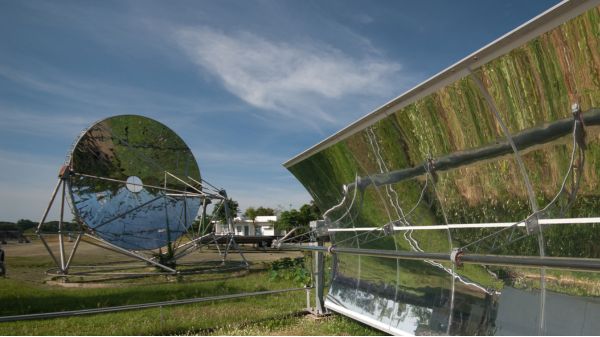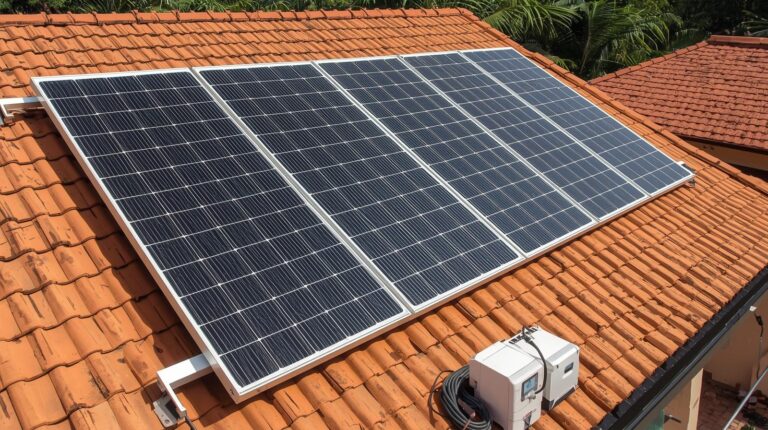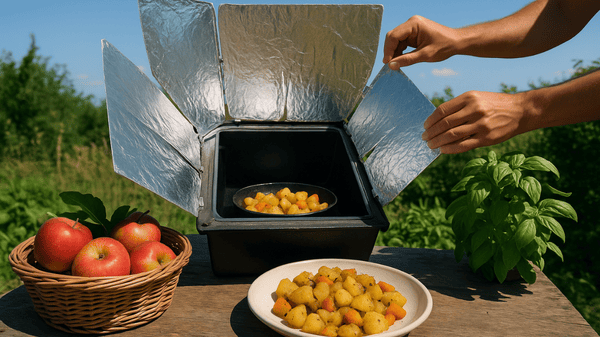Concentrated Solar Power Systems (CSP) provide you with an array of benefits. They offer high energy efficiency rates, thanks to mirror technology that utilizes sunlight to improve energy. You’ll contribute to a healthier environment due to greatly reduced greenhouse gas emissions.
CSP systems come with a great potential for energy storage, giving you access to power when needed. Not only do they consume less water than traditional energy sources, but they also promise long-term cost-effectiveness and flexibility in installation locations. Hence, as a solution for sustainable power, CSP systems are worth your consideration for a deeper understanding of their benefits and potential.
Key Takeaways
- Concentrated solar power systems offer high energy efficiency rates thanks to advanced mirror technology and thermal storage systems.
- They significantly reduce greenhouse gas emissions, contributing to cleaner air and a healthier environment.
- These systems have the potential for energy storage, providing reliable and dispatchable power for peak demand periods.
- They consume less water than traditional energy sources, promoting sustainable water resource management.
- Concentrated solar power systems are cost-effective in the long run, offering low maintenance costs and economic incentives.
High Energy Efficiency Rates
Harnessing the sun’s immense power, concentrated solar power systems achieve astonishingly high energy efficiency rates. You, as a seeker of liberation, can tap into this powerful, sustainable energy source, and here’s how it works.
These systems use mirror technology to gather and concentrate sunlight onto a small area, enhancing its energy through heat transfer. This intense heat is then stored in a thermal storage system, ready for when you need power. The energy dispatch process guarantees you get the right amount of energy when you need it, smoothly integrating with the grid for seamless use.
The solar tracking feature of these systems allows continuous exposure to the sun, optimizing efficiency throughout the day. The system’s scalability means you can adapt it to suit your power needs, from small-scale domestic use to large-scale industrial applications.
What about maintenance? Well, with proper practices, these systems can last for many years, offering an excellent return on investment. Hybrid systems can further optimize efficiency, combining solar with other renewable sources.
Take control of your energy needs. Embrace the high efficiency, sustainability, and liberation that concentrated solar power systems offer. It’s your future. Power it wisely.
Reduced Greenhouse Gas Emissions
Not only do concentrated solar power systems offer impressive energy efficiency, but they also contribute considerably to reducing greenhouse gas emissions. Imagine a world where the air you breathe is cleaner and the environment is healthier. Thanks to the advancements in solar technology, this isn’t just a dream, it’s becoming a reality.
Solar technology advancements have made it possible for us to harness more power from the sun than ever before. When you opt for solar energy, you’re choosing to support a technology that doesn’t rely on burning fossil fuels. Unlike traditional power sources, solar power doesn’t release harmful gases into our atmosphere.
The environmental policy impacts of shifting to solar energy are massive. Policies that encourage the use of solar energy, such as tax incentives and subsidies, can help us reduce our carbon footprint. Every kilowatt-hour of solar energy we use is a step towards liberation from the harmful effects of fossil fuels.
Potential for Energy Storage
One of the most exciting aspects of concentrated solar power systems is their potential for energy storage.
You see, these systems harness thermal energy, which can be stored for later use, giving them a significant advantage over other renewable energy sources. This capability allows for grid integration, providing dispatchable power that can be used when it’s most needed.
Now, imagine the freedom and autonomy this system scalability offers. Thanks to technology advancements, you’re no longer tied to traditional energy sources that fluctuate with market trends. You have the power to contribute to a more sustainable energy future. However, it’s not just about the technology itself.
Investment incentives and a favorable energy policy can also play an essential role in making concentrated solar power systems more accessible and attractive to adopt. But remember, change doesn’t happen overnight. It’s a gradual process that requires patience and persistence.
Lower Water Consumption
Compared to traditional energy sources, concentrated solar power systems use considerably less water. This is a huge victory for your thirst for freedom from unsustainable practices. With these systems, you’re not just harnessing the sun’s energy, you’re also practicing smart water resource management.
Why? It’s all about how these systems generate power. They focus sunlight to heat a liquid that then produces steam to power a turbine. This process is much more efficient than the steam generation in conventional power plants, leading to a reduction in water consumption.
Plus, the water used in the cooling process can be recirculated, meaning less is needed in the long run. These systems also contribute to evaporation reduction. Less water used means less water exposed and evaporated. You’re not just saving water, but also reducing the strain on our precious water resources.
Long-term Cost Effectiveness
Your wallet’s long-term health can greatly benefit from concentrated solar power systems. Yes, the initial investment might seem steep, but remember, you’re investing in liberation from ever-rising energy prices. The maintenance costs are low, and the economic incentives, such as rebates and tax credits, can considerably offset your upfront costs.
Beyond your personal benefits, you’re also contributing to job creation in the renewable energy sector. Technological advancements are continuously reducing costs and improving efficiency. Grid integration is becoming smoother, thanks to policy support and market trends favoring renewable energy.
It’s important to note that policy support isn’t just about government handouts. It’s about creating an environment where sustainable energy solutions are encouraged, and where you, as a consumer, are rewarded for making smart, sustainable choices.
Versatility of Installation Locations
You’re about to explore the versatility of installation locations for concentrated solar power systems. Consider first the geographical flexibility of these systems; they’re not just for sun-drenched deserts. From urban rooftops to rural fields, and with careful landscape impact considerations, you’ll find these systems can fit in more places than you might think.
Geographical Flexibility
The versatility of installation locations for concentrated solar power systems is a significant advantage. You have the freedom to choose the most suitable site based on essential factors like sunlight availability and land use. It’s not just about finding a sunny spot; it’s also about ensuring that the site selection aligns with local policies and community acceptance.
Imagine the possibilities when you’re not tied down to specific geographic constraints. You could establish your solar farm in remote areas where infrastructure readiness is high, or integrate it into an existing grid in more populated areas. This level of geographical flexibility allows you to tailor your solar project to meet your specific needs and the needs of those within your community.
The environmental impact is also a consideration in your site selection. By choosing a location that minimizes negative effects on the surrounding environment, you’re not just investing in clean energy, but also contributing to the overall well-being of your community.
This geographical flexibility gives you the power to create a sustainable energy solution that works best for you. With concentrated solar power systems, you’re not just harnessing the sun’s power; you’re also embracing a more liberated approach to energy production.
Urban vs. Rural Installations
When it comes to choosing between urban and rural installations for concentrated solar power systems, there’s a lot to contemplate. Urban infrastructure, with its dense population and towering buildings, presents both unique challenges and opportunities. The installation challenges here can be substantial, with space being a prime concern.
However, the abundance of rooftops can become assets with the right technological adaptation and regulatory frameworks in place.
On the other hand, rural land use offers its own advantages. You have more room to set up systems, which could potentially generate more energy. But you also must consider factors like energy accessibility and grid integration. In rural areas, community acceptance might be easier to achieve, given the lesser disruption to everyday life.
In either scenario, whether you’re dealing with urban or rural installations, the versatility of concentrated solar power systems comes to the fore. They can be adapted to suit different environments and regulatory requirements, providing an effective and sustainable solution for energy needs.
Landscape Impact Considerations
Let’s consider three primary landscape impact considerations of installing concentrated solar power systems.
To begin with, the visual aesthetics. You’re probably thinking, “Won’t massive solar panels be an eyesore?” Well, that’s not necessarily the case. With advancements in technology, these systems have become more compact and visually pleasing. They can be installed in non-intrusive locations, maintaining the natural beauty of your surroundings.
Next, land use is a critical aspect. Concentrated solar power systems do require a considerable amount of space. However, they’re versatile enough to be installed in a variety of locations, including deserts, unused industrial zones, or large rooftops. This flexibility allows for the best use of land resources without greatly altering the landscape.
Frequently Asked Questions
What Is the Average Lifespan of a Concentrated Solar Power System?
You’re looking at a lifespan of around 20 to 25 years for a concentrated solar power system. But remember, it’s not just about longevity. A cost analysis shows they’re cost-effective over time. Their efficiency metrics are impressive too, converting about 15%-25% of sunlight into usable energy.
Are There Any Potential Safety Issues With Concentrated Solar Power Systems?
Yes, you should be aware of potential safety issues with concentrated solar power systems. One major concern is thermal hazards due to the high temperatures involved. It’s essential to handle these systems properly to avoid injury. Operational risks such as equipment failure are also present. Regular maintenance and safety checks can mitigate these risks. Despite these concerns, if managed correctly, these systems provide a safe and sustainable energy source.
How Does Weather Impact the Functionality of Concentrated Solar Power Systems?
Weather considerably impacts your concentrated solar power system’s efficiency. On clear days, you’ll reap maximum benefits. However, weather variability like cloudy skies can reduce the system’s effectiveness.
Rain, snow, or dust can also obstruct sunlight, leading to decreased solar efficiency. As a result, maintaining your system and situating it in a region with consistent, strong sunlight will help you get the most out of it. It’s not foolproof, but it’s a renewable energy source worth investing in.
Can Concentrated Solar Power Systems Be Integrated With Other Renewable Energy Sources?
Yes, you can integrate concentrated solar power systems with other renewable energy sources, enhancing system efficiency. Hybrid solutions, combining solar with wind or hydro, can provide reliable, round-the-clock energy. Energy storage solutions, like batteries, can store surplus power for later use.
Additionally, grid integration allows excess energy to be distributed to other users, optimizing overall utilization. This flexibility makes these systems a valuable addition to our renewable energy mix.
What Are the Maintenance Requirements for a Concentrated Solar Power System?
Maintaining a concentrated solar power system is akin to tending a garden. It needs routine inspections to guarantee peak performance. You’ll have to check the mirrors for cleanliness and alignment. The heat transfer fluid should be monitored for quality and temperature. Additionally, the mechanical parts require regular servicing. Don’t overlook the power block and steam turbine either. With diligent care, your system will function efficiently and last longer.




